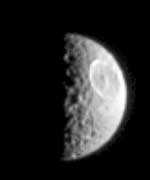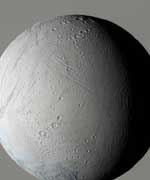This false-color composite was created with images taken during the Cassini spacecraft’s closest flyby of Titan on April 16, 2005.
It was created by combining two infrared images (taken at 938 and 889 nanometers) with a visible light image (taken at 420 nanometers). Green represents areas where Cassini is able to see down to the surface. Red represents areas high in Titan’s stratosphere where atmospheric methane is absorbing sunlight. Blue along the moon’s outer edge represents visible violet wavelengths at which the upper atmosphere and detached hazes are better seen.
A similar false-color image showing the opposite hemisphere of Titan was created from images taken during Cassini’s first close flyby of the smoggy moon in October 2004 (see PIA06139). At that time, clouds could be seen near Titan’s south pole, but in these more recent observations no clouds are seen.
North on Titan is up and tilted 30 degrees to the right.
The images used to create this composite were taken with the Cassini spacecraft wide angle camera on April 16, 2005, at distances ranging from approximately 173,000 to 168,200 kilometers (107,500 to 104,500 miles) from Titan and from a Sun-Titan-spacecraft, or phase, angle of 56 degrees. Resolution in the images approximately 10 kilometers per pixel.
The Cassini-Huygens mission is a cooperative project of NASA, the European Space Agency and the Italian Space Agency. The Jet Propulsion Laboratory, a division of the California Institute of Technology in Pasadena, manages the mission for NASA’s Science Mission Directorate, Washington, D.C. The Cassini orbiter and its two onboard cameras were designed, developed and assembled at JPL. The imaging team is based at the Space Science Institute, Boulder, Colo.
For more information about the Cassini-Huygens mission visit http://saturn.jpl.nasa.gov . For additional images visit the Cassini imaging team homepage http://ciclops.org .
Original Source: NASA/JPL News Release


